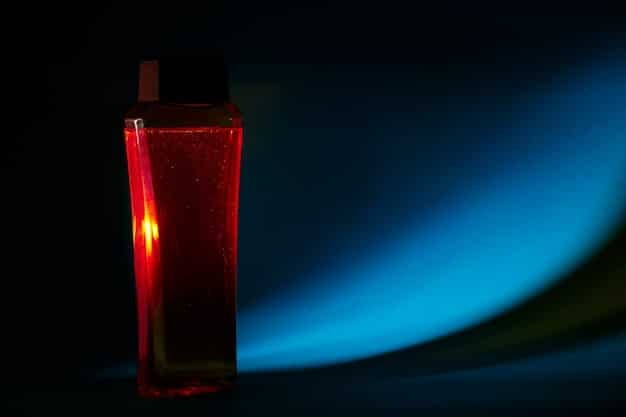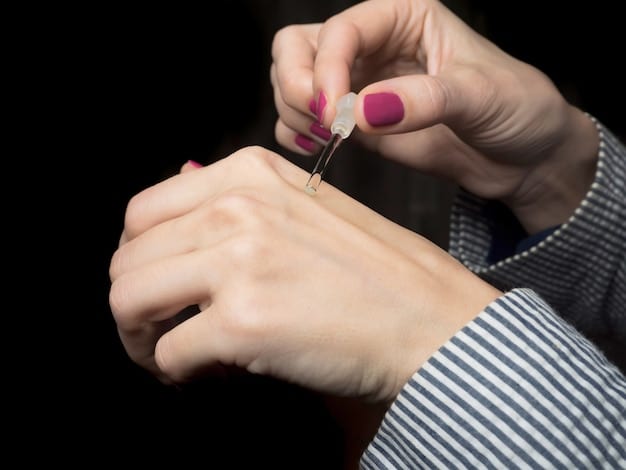Fragrance Review: Unveiling the Scent Secrets You Need to Know

Fragrance review is a comprehensive analysis of a perfume or cologne, encompassing its composition, longevity, projection, and overall impression, helping consumers make informed decisions about their scent preferences.
Embarking on a journey to find your signature scent can be both exciting and overwhelming. A fragrance review serves as your compass, guiding you through the complex world of perfumes and colognes, offering insights into their unique characteristics and helping you discover the perfect fragrance to match your personality and style.
Understanding the Essence of a Fragrance Review
A fragrance review is more than just a simple opinion; it’s a critical appraisal of a scent’s various elements. It delves into the intricate notes that make up the fragrance, examining how they interact and evolve over time. Let’s break down the key components that constitute a comprehensive fragrance review.
The Olfactory Pyramid: Deconstructing the Scent
The olfactory pyramid is a crucial concept in understanding fragrance composition. It categorizes the scent’s notes into three layers: top, middle (or heart), and base notes.
- Top Notes: These are the initial scents you perceive upon application. They are typically light and refreshing, designed to make a strong first impression. Examples include citrus, herbs, and aquatic accords.
- Middle Notes: Also known as heart notes, these emerge after the top notes fade. They form the core of the fragrance and provide its character. Common middle notes include floral, spicy, and fruity elements.
- Base Notes: These are the long-lasting notes that anchor the fragrance. They provide depth and richness, ensuring the scent lingers on the skin. Examples include woody, musky, and amber accords.
Longevity and Sillage: Measuring Performance
The performance of a fragrance is often assessed by its longevity (how long it lasts on the skin) and sillage (the trail it leaves behind). Longevity can range from a few hours to an entire day, while sillage can be intimate (close to the skin), moderate (noticeable but not overpowering), or strong (creating a significant presence).

Understanding these elements is essential for anyone looking to navigate the world of fragrances with confidence. A good fragrance review will dissect these aspects, providing a clear picture of what to expect from a particular scent.
The Art of Describing Scents: A Fragrance Lexicon
Describing scents is inherently subjective, but a well-crafted fragrance review relies on a specific vocabulary to convey precise impressions. Familiarizing yourself with these terms can greatly enhance your understanding and appreciation of fragrance reviews.
Terms like “citrusy,” “woody,” “floral,” and “spicy” are commonly used to describe the dominant notes in a fragrance. However, more nuanced descriptors can add depth and precision to the review.
Common Descriptors in Fragrance Reviews
These terms go beyond simple identification, evoking specific sensations and emotions associated with the scent.
- Aromatic: Typically refers to fragrances with herbaceous or slightly medicinal notes, often found in men’s fragrances.
- Gourmand: Describes scents that evoke edible or dessert-like qualities, such as vanilla, chocolate, or caramel.
- Aquatic: Conveys a sense of the ocean or fresh water, often featuring marine or ozonic notes.
- Powdery: Suggests a soft, comforting, and slightly sweet scent, reminiscent of baby powder or cosmetics.
By incorporating these descriptors, fragrance reviews can paint a vivid picture of the scent’s character, enabling readers to imagine the fragrance even before experiencing it firsthand.
Ultimately, the goal of a fragrance review is to provide a multi-sensory experience through the power of language, creating a bond between the reader and the aroma being described.
Finding Reliable Fragrance Reviews: Navigating the Online Landscape
With countless fragrance reviews available online, discerning reliable sources from biased or uninformed opinions is crucial. A trustworthy review should be objective, well-reasoned, and based on genuine experience.
Characteristics of a Credible Review Source
Look for reviewers who demonstrate a deep understanding of fragrance composition, performance, and context. They should be able to articulate their impressions clearly and provide a balanced perspective.
Consider these factors when evaluating a fragrance review:
- Expertise: Does the reviewer possess a demonstrable knowledge of fragrances, including notes, accords, and perfumery techniques?
- Objectivity: Does the review present a balanced perspective, acknowledging both strengths and weaknesses of the fragrance?
- Transparency: Does the reviewer disclose any potential biases, such as sponsored content or affiliations with fragrance brands?
- Community Validation: Do other users find the review helpful and informative? Look for reviews with positive feedback and engagement.

By carefully assessing the credibility of review sources, you can make informed decisions and avoid being misled by biased or unreliable information.
The Role of Personal Preference in Fragrance Reviews
While objective analysis is essential, personal preference inevitably plays a role in shaping fragrance reviews. It’s important to recognize that scent perception is subjective, and what appeals to one individual may not appeal to another.
Embracing Subjectivity: Understanding Individual Scent Preferences
Factors such as personal memories, cultural associations, and skin chemistry can all influence how a fragrance is perceived. A reviewer’s personal experiences and preferences can color their impressions, leading to subjective interpretations.
When reading fragrance reviews, consider these factors:
- Individual Skin Chemistry: Fragrances can smell different on different people due to variations in skin pH, oil production, and other factors.
- Personal Associations: Scents can trigger powerful memories and emotions, leading to positive or negative associations.
- Cultural Context: Cultural background can influence fragrance preferences, with different cultures appreciating different scent profiles.
Ultimately, personal preference is a key ingredient in the fragrance experience. Acknowledging this subjectivity can help you interpret reviews with a grain of salt and prioritize your own scent preferences.
The best fragrance review is one that acknowledges the interplay between objective analysis and subjective experience, providing a balanced and nuanced perspective.
Interpreting Fragrance Reviews: A Practical Guide
Once you’ve found reliable reviews, the next step is to interpret them effectively. Pay attention to the details provided and consider how they align with your own scent preferences and priorities. A fragrance review can be your guide to find the best option.
Key Takeaways from Fragrance Reviews
Focus on specific aspects such as note breakdowns, performance metrics, and comparisons to similar fragrances. This will help you build a comprehensive understanding of the scent’s characteristics and potential appeal.
Use Cases
- Note Breakdown: Identify the key ingredients and accords that define the fragrance’s character.
- Longevity and Sillage: Determine how long the fragrance lasts and how far it projects.
- Seasonal Suitability: Assess whether the fragrance is best suited for warm or cool weather.
- Occasion Appropriateness: Determine whether the fragrance is ideal for casual, formal, or special occasions.
By carefully analyzing these elements, you can develop a more informed understanding of the fragrance and make a more confident purchasing decision.
Reading a fragrance review is the best way to decide if the purchase is right for you.
Beyond the Review: Sampling and Testing Fragrances
While fragrance reviews can provide valuable insights, nothing replaces the experience of sampling and testing fragrances firsthand. A paper strip at the store is not enough, wear the fragrance so it combines with your body chemistry.
The Importance of Personal Experience
Obtain samples or decants of fragrances you’re interested in and wear them on your skin for a full day. This will allow you to experience how the scent evolves over time and how it interacts with your unique body chemistry.
Personal tips
Consider these factors during testing:
- Skin Chemistry: How does the fragrance smell on your skin compared to a paper strip?
- Longevity: How long does the fragrance last on your skin?
- Sillage: How far does the fragrance project from your skin?
By combining the insights from fragrance reviews with your own personal experience, you can make a truly informed decision and discover a fragrance that resonates with you on a deeper level.
| Key Aspect | Brief Description |
|---|---|
| 👃 Scent Notes | Understand top, middle, and base notes for a scent profile. |
| ⏱️ Longevity & Sillage | Gauge how long the fragrance lasts and its projection strength. |
| 🌐 Review Credibility | Check for expertise, objectivity, and transparency in reviews. |
| 🧪 Personal Testing | Always sample fragrances on your skin to assess individual performance. |
Frequently Asked Questions (FAQ)
▼
Eau de parfum (EDP) has a higher concentration of fragrance oils (15-20%) compared to eau de toilette (EDT) (5-15%), resulting in longer lasting scent and stronger projection. EDT is generally lighter and more suitable for warmer weather or casual wear.
▼
Spray a small amount of the fragrance on your wrist or inner elbow, avoiding rubbing which can alter the scent. Allow the fragrance to develop over several hours to experience the full range of notes. Consider testing in different environments.
▼
A “blind buy” refers to purchasing a fragrance without sampling it first, relying solely on reviews, descriptions, and community feedback. It’s a risky approach, but can be rewarding if you carefully research the fragrance profile.
▼
Skin chemistry, primarily determined by skin pH and oil production, can significantly alter how a fragrance smells on an individual. A fragrance that smells wonderful on one person might smell completely different, or even unpleasant, on another.
▼
Common fragrance notes include citruses like lemon and bergamot, florals like rose and jasmine, woods like cedar and sandalwood, and spices like cinnamon and pepper. Accords are combinations of notes that create a unified scent impression, such as a marine accord.
Conclusion
Ultimately, understanding the nuances of a fragrance review empowers you to navigate the vast world of scents with greater confidence. By considering both objective analysis and personal preference, you can discover fragrances that resonate with your unique personality and style, transforming the act of choosing a scent into a truly rewarding experience.





